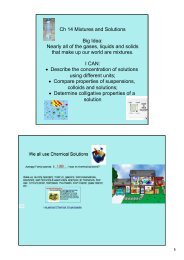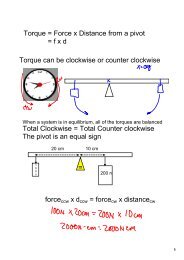Ch. 16 Prokaryotes and Protists
Ch. 16 Prokaryotes and Protists
Ch. 16 Prokaryotes and Protists
Create successful ePaper yourself
Turn your PDF publications into a flip-book with our unique Google optimized e-Paper software.
<strong>Ch</strong>apter <strong>16</strong> Microbial Life: <strong>Prokaryotes</strong> <strong>and</strong><strong>Protists</strong>Figure <strong>16</strong>.0_1PowerPoint Lectures forCampbell Biology: Concepts & Connections, Seventh EditionReece, Taylor, Simon, <strong>and</strong> Dickey© 2012 Pearson Education, Inc. Lecture by Edward J. ZaliskoFigure <strong>16</strong>.0_2Figure <strong>16</strong>.0_3<strong>Ch</strong>apter <strong>16</strong>: Big Ideas<strong>Prokaryotes</strong><strong>Protists</strong><strong>16</strong>.1 <strong>Prokaryotes</strong> are diverse <strong>and</strong> widespreadPROKARYOTES• Prokaryotic cells are smaller than eukaryotic cells.– <strong>Prokaryotes</strong> range from 1–5 µm in diameter.– Eukaryotes range from 10–100 µm in diameter.• The collective biomass of prokaryotes is at least 10times that of all eukaryotes.© 2012 Pearson Education, Inc.© 2012 Pearson Education, Inc.
Figure <strong>16</strong>.1<strong>16</strong>.1 <strong>Prokaryotes</strong> are diverse <strong>and</strong> widespread• <strong>Prokaryotes</strong> live in habitats– too cold,– too hot,– too salty,– too acidic, <strong>and</strong>– too alkaline for eukaryotes to survive.• Some bacteria are pathogens, causing disease.But most bacteria on our bodies are benign orbeneficial.© 2012 Pearson Education, Inc.<strong>16</strong>.1 <strong>Prokaryotes</strong> are diverse <strong>and</strong> widespread• Several hundred species of bacteria live in <strong>and</strong> onour bodies,– decomposing dead skin cells,– supplying essential vitamins, <strong>and</strong>– guarding against pathogenic organisms.• <strong>Prokaryotes</strong> in soil decompose dead organisms,sustaining chemical cycles.<strong>16</strong>.2 External features contribute to the success ofprokaryotes• Prokaryotic cells have three common cell shapes.– Cocci are spherical prokaryotic cells. They sometimesoccur in chains that are called streptococci.– Bacilli are rod-shaped prokaryotes. Bacilli may also bethreadlike, or filamentous.– Spiral prokaryotes are like a corkscrew.– Short <strong>and</strong> rigid prokaryotes are called spirilla.– Longer, more flexible cells are called spirochetes.© 2012 Pearson Education, Inc.© 2012 Pearson Education, Inc.Figure <strong>16</strong>.2ACocci Bacilli Spirochete<strong>16</strong>.2 External features contribute to the success ofprokaryotes• Nearly all prokaryotes have a cell wall. Cell walls– provide physical protection <strong>and</strong>– prevent the cell from bursting in a hypotonicenvironment.• When stained with Gram stain, cell walls ofbacteria are either– Gram-positive, with simpler cell walls containingpeptidoglycan, or– Gram-negative, with less peptidoglycan, <strong>and</strong> morecomplex <strong>and</strong> more likely to cause disease.© 2012 Pearson Education, Inc.
Figure <strong>16</strong>.2B<strong>16</strong>.2 External features contribute to the success ofprokaryotes• The cell wall of many prokaryotes is covered by acapsule, a sticky layer of polysaccharides orprotein.• The capsule– enables prokaryotes to adhere to their substrate or toother individuals in a colony <strong>and</strong>– shields pathogenic prokaryotes from attacks by a host’simmune system.© 2012 Pearson Education, Inc.Figure <strong>16</strong>.2C<strong>16</strong>.2 External features contribute to the success ofprokaryotesCapsuleTonsil cell• Some prokaryotes have external structures thatextend beyond the cell wall.– Flagella help prokaryotes move in their environment.– Hairlike projections called fimbriae enable prokaryotesto stick to their substrate or each other.Bacterium© 2012 Pearson Education, Inc.Figure <strong>16</strong>.2D<strong>16</strong>.3 Populations of prokaryotes can adapt rapidlyto changes in the environmentFimbriaeFlagella• Prokaryote population growth– occurs by binary fission,– can rapidly produce a new generation within hours, <strong>and</strong>– can generate a great deal of genetic variation– by spontaneous mutations,– increasing the likelihood that some members of the populationwill survive changes in the environment.© 2012 Pearson Education, Inc.
<strong>16</strong>.3 Populations of prokaryotes can adapt rapidlyto changes in the environmentFigure <strong>16</strong>.3A<strong>Ch</strong>romosomePlasmids• The genome of a prokaryote typically– has about one-thous<strong>and</strong>th as much DNA as aeukaryotic genome <strong>and</strong>– is one long, circular chromosome packed into a distinctregion of the cell.• Many prokaryotes also have additional small,circular DNA molecules called plasmids, whichreplicate independently of the chromosome.© 2012 Pearson Education, Inc.<strong>16</strong>.3 Populations of prokaryotes can adapt rapidlyto changes in the environmentFigure <strong>16</strong>.3B• Some prokaryotes form specialized cells calledendospores that remain dormant through harshconditions.Endospore• Endospores can survive extreme heat or cold.© 2012 Pearson Education, Inc.<strong>16</strong>.4 <strong>Prokaryotes</strong> have unparalleled nutritionaldiversity• <strong>Prokaryotes</strong> exhibit much more nutritional diversitythan eukaryotes.• Two sources of energy are used.– Phototrophs capture energy from sunlight.– <strong>Ch</strong>emotrophs harness the energy stored in chemicals.<strong>16</strong>.4 <strong>Prokaryotes</strong> have unparalleled nutritionaldiversity• Two sources of carbon are used by prokaryotes.– Autotrophs obtain carbon atoms from carbon dioxide.– Heterotrophs obtain their carbon atoms from theorganic compounds present in other organisms.© 2012 Pearson Education, Inc.© 2012 Pearson Education, Inc.
<strong>16</strong>.6 CONNECTION: <strong>Prokaryotes</strong> help clean upthe environment• <strong>Prokaryotes</strong> are useful for cleaning up contaminantsin the environment because prokaryotes– have great nutritional diversity,– are quickly adaptable, <strong>and</strong>– can form biofilms.<strong>16</strong>.6 CONNECTION: <strong>Prokaryotes</strong> help clean upthe environment• Bioremediation is the use of organisms to removepollutants from– soil,– air, or– water.© 2012 Pearson Education, Inc.© 2012 Pearson Education, Inc.<strong>16</strong>.6 CONNECTION: <strong>Prokaryotes</strong> help clean upthe environment• Prokaryotic decomposers are the mainstays ofsewage treatment facilities.– Raw sewage is first passed through a series of screens<strong>and</strong> shredders.– Solid matter then settles out from the liquid waste,forming sludge.– Sludge is gradually added to a culture of anaerobicprokaryotes, including bacteria <strong>and</strong> archaea.– The microbes decompose the organic matter into materialthat can be placed in a l<strong>and</strong>fill or used as fertilizer.<strong>16</strong>.6 CONNECTION: <strong>Prokaryotes</strong> help clean upthe environment• Liquid wastes are treated separately from thesludge.– Liquid wastes are sprayed onto a thick bed of rocks.– Biofilms of aerobic bacteria <strong>and</strong> fungi growing on therocks remove much of the dissolved organic material.– Fluid draining from the rocks is sterilized <strong>and</strong> thenreleased, usually into a river or ocean.© 2012 Pearson Education, Inc.© 2012 Pearson Education, Inc.Figure <strong>16</strong>.6A<strong>16</strong>.6 CONNECTION: <strong>Prokaryotes</strong> help clean upthe environment• Bioremediation is becoming an important tool forcleaning up toxic chemicals released into the soil<strong>and</strong> water by industrial processes.Rotatingspray armRock bed coatedwith aerobicprokaryotes<strong>and</strong> fungi• Environmental engineers change the naturalenvironment to accelerate the activity of naturallyoccurring prokaryotes capable of metabolizingpollutants.Liquid wastesOutflow© 2012 Pearson Education, Inc.
Figure <strong>16</strong>.6B<strong>16</strong>.7 Bacteria <strong>and</strong> archaea are the two mainbranches of prokaryotic evolution• New studies of representative genomes ofprokaryotes <strong>and</strong> eukaryotes strongly support thethree-domain view of life.– <strong>Prokaryotes</strong> are now classified into two domains:– Bacteria <strong>and</strong>– Archaea.– Archaea have at least as much in common witheukaryotes as they do with bacteria.© 2012 Pearson Education, Inc.Table <strong>16</strong>.7<strong>16</strong>.8 Archaea thrive in extreme environments—<strong>and</strong> in other habitats• Archaeal inhabitants of extreme environmentshave unusual proteins <strong>and</strong> other molecularadaptations that enable them to metabolize <strong>and</strong>reproduce effectively.– Extreme halophiles thrive in very salty places.– Extreme thermophiles thrive in– very hot water, such as geysers, <strong>and</strong>– acid pools.© 2012 Pearson Education, Inc.Figure <strong>16</strong>.8A<strong>16</strong>.8 Archaea thrive in extreme environments—<strong>and</strong> in other habitats• Methanogens– live in anaerobic environments,– give off methane as a waste product from– the digestive tracts of cattle <strong>and</strong> deer <strong>and</strong>– decomposing materials in l<strong>and</strong>fills.© 2012 Pearson Education, Inc.
Figure <strong>16</strong>.8B<strong>16</strong>.9 Bacteria include a diverse assemblage ofprokaryotes• The domain Bacteria is currently divided into fivegroups, based on comparisons of geneticsequences.• 1. Proteobacteria– are all gram negative,– share a particular rRNA sequence, <strong>and</strong>– represent all four modes of nutrition.© 2012 Pearson Education, Inc.<strong>16</strong>.9 Bacteria include a diverse assemblage ofprokaryotesFigure <strong>16</strong>.9A– Thiomargarita namibiensis is a type of proteobacteriathat– is a giant among prokaryotes, typically ranging up to100–300 microns in diameter,– uses H 2 S to generate organic molecules from CO 2 ,<strong>and</strong>– produces sulfur wastes, seen as small greenishglobules in the following figure.© 2012 Pearson Education, Inc.<strong>16</strong>.9 Bacteria include a diverse assemblage ofprokaryotesFigure 32.13B– Proteobacteria also include Rhizobium species thatShoot– live symbiotically in root nodules of legumes <strong>and</strong>– convert atmospheric nitrogen gas into a form usableby their legume host.– Symbiosis is a close association betweenorganisms of two or more species.– Rhizobium is an endosymbiont, living within anotherspecies.Bacteria withinNodulesvesicle in anRootsinfected cell© 2012 Pearson Education, Inc.
<strong>16</strong>.9 Bacteria include a diverse assemblage ofprokaryotesFigure <strong>16</strong>.9B• 2. Gram-positive bacteria– rival proteobacteria in diversity <strong>and</strong>– include the actinomycetes common in soil.– Streptomyces is often cultured by pharmaceuticalcompanies as a source of many antibiotics.© 2012 Pearson Education, Inc.<strong>16</strong>.9 Bacteria include a diverse assemblage ofprokaryotesFigure <strong>16</strong>.9C• 3. Cyanobacteria– Cyanobacteria are the only group of prokaryotes withplantlike, oxygen-generating photosynthesis.Photosyntheticcells– Some species, such as Anabaena, have specializedcells that fix nitrogen.Nitrogen-fixingcells© 2012 Pearson Education, Inc.<strong>16</strong>.9 Bacteria include a diverse assemblage ofprokaryotesFigure <strong>16</strong>.9D• 4. <strong>Ch</strong>lamydias– <strong>Ch</strong>lamydias live inside eukaryotic host cells.– <strong>Ch</strong>lamydia trachomatis– is a common cause of blindness in developingcountries <strong>and</strong>– is the most common sexually transmitted disease inthe United States.© 2012 Pearson Education, Inc.
<strong>16</strong>.9 Bacteria include a diverse assemblage ofprokaryotesFigure <strong>16</strong>.9E• 5. Spirochetes are– helical bacteria <strong>and</strong>– notorious pathogens, causing– syphilis <strong>and</strong>– Lyme disease.© 2012 Pearson Education, Inc.<strong>16</strong>.10 CONNECTION: Some bacteria causediseaseFigure <strong>16</strong>.10• All organisms are almost constantly exposed topathogenic bacteria.• Most bacteria that cause illness do so by producinga poison.– Exotoxins are proteins that bacterial cells secrete intotheir environment.– Endotoxins are components of the outer membrane ofgram-negative bacteria.© 2012 Pearson Education, Inc.<strong>16</strong>.11 SCIENTIFIC DISCOVERY: Koch’spostulates are used to prove that abacterium causes a disease• Koch’s postulates are four essential conditions usedto establish that a certain bacterium is the cause of adisease. They are1. find the bacterium in every case of the disease,2. isolate the bacterium from a person who has the disease<strong>and</strong> grow it in pure culture,3. show that the cultured bacterium causes the diseasewhen transferred to a healthy subject, <strong>and</strong>4. isolate the bacterium from the experimentally infectedsubject.<strong>16</strong>.11 SCIENTIFIC DISCOVERY: Koch’spostulates are used to prove that abacterium causes a disease• Koch’s postulates were used to demonstrate thatthe bacterium Helicobacter pylori is the cause ofmost peptic ulcers.• The 2005 Nobel Prize in Medicine was awarded toBarry Marshall <strong>and</strong> Robin Warren for thisdiscovery.© 2012 Pearson Education, Inc.© 2012 Pearson Education, Inc.
Figure <strong>16</strong>.11<strong>16</strong>.12 CONNECTION: Bacteria can be used asbiological weapons• Bacteria that cause anthrax <strong>and</strong> the plague can beused as biological weapons.– Bacillus anthracis killed five people in the United Statesin 2001.– Yersinia pestis bacteria– are typically carried by rodents <strong>and</strong> transmitted by fleas,causing the plague <strong>and</strong>– can cause a pneumonic form of plague if inhaled.© 2012 Pearson Education, Inc.Figure <strong>16</strong>.12<strong>16</strong>.12 CONNECTION: Bacteria can be used asbiological weapons• Clostridium botulinum produces the exotoxinbotulinum, the deadliest poison on earth.• Botulinum blocks transmission of nerve signals <strong>and</strong>prevents muscle contraction.© 2012 Pearson Education, Inc.PROTISTS<strong>16</strong>.13 <strong>Protists</strong> are an extremely diverse assortmentof eukaryotes• <strong>Protists</strong>– are a diverse collection of mostly unicellular eukaryotes,– may constitute multiple kingdoms within the Eukarya,<strong>and</strong>– refer to eukaryotes that are not– plants,– animals, or– fungi.© 2012 Pearson Education, Inc.© 2012 Pearson Education, Inc.
<strong>16</strong>.13 <strong>Protists</strong> are an extremely diverse assortmentof eukaryotesFigure <strong>16</strong>.13A• <strong>Protists</strong> obtain their nutrition in many ways. <strong>Protists</strong>includeAutotrophyHeterotrophyMixotrophy– autotrophs, called algae, producing their food byphotosynthesis,– heterotrophs, called protozoans, eating bacteria <strong>and</strong>other protists,– heterotrophs, called parasites, deriving their nutritionfrom a living host, <strong>and</strong>– mixotrophs, using photosynthesis <strong>and</strong> heterotrophy.Caulerpa, a green algaGiardia, a parasiteEuglena© 2012 Pearson Education, Inc.<strong>16</strong>.13 <strong>Protists</strong> are an extremely diverse assortmentof eukaryotesFigure <strong>16</strong>.13B• <strong>Protists</strong> are found in many habitats including– anywhere there is moisture <strong>and</strong>– the bodies of host organisms.© 2012 Pearson Education, Inc.<strong>16</strong>.13 <strong>Protists</strong> are an extremely diverse assortmentof eukaryotes• Recent molecular <strong>and</strong> cellular studies indicate thatnutritional modes used to categorize protists do notreflect natural clades.• Protist phylogeny remains unclear.• One hypothesis, used here, proposes fivemonophyletic supergroups.<strong>16</strong>.14 EVOLUTION CONNECTION: Secondaryendosymbiosis is the key to much of protistdiversity• The endosymbiont theory explains the origin ofmitochondria <strong>and</strong> chloroplasts.– Eukaryotic cells evolved when prokaryotes establishedresidence within other, larger prokaryotes.– This theory is supported by present-day mitochondria <strong>and</strong>chloroplasts that– have structural <strong>and</strong> molecular similarities toprokaryotic cells <strong>and</strong>– replicate <strong>and</strong> use their own DNA, separate from thenuclear DNA of the cell.© 2012 Pearson Education, Inc.© 2012 Pearson Education, Inc.
Figure <strong>16</strong>.14_s3<strong>16</strong>.14 EVOLUTION CONNECTION: Secondaryendosymbiosis is the key to much of protistdiversityPrimaryendosymbiosisGreen alga• Secondary endosymbiosis is<strong>Ch</strong>loroplastEvolved intoCyanobacterium chloroplast1 NucleusHeterotrophiceukaryote23 Autotrophiceukaryotes4 Heterotrophiceukaryotes– the process in which an autotrophic eukaryotic protistbecame endosymbiotic in a heterotrophic eukaryoticprotist <strong>and</strong>– key to protist diversity.<strong>Ch</strong>loroplastRed alga© 2012 Pearson Education, Inc.Figure <strong>16</strong>.14_s5<strong>16</strong>.15 <strong>Ch</strong>romalveolates represent the range ofprotist diversityPrimaryendosymbiosis<strong>Ch</strong>loroplastEvolved intoCyanobacterium chloroplastGreen algaSecondaryendosymbiosisRemnant ofgreen algaEuglena• <strong>Ch</strong>romalveolates include– diatoms, unicellular algae with a glass cell wallcontaining silica,1 NucleusHeterotrophiceukaryote23 Autotrophiceukaryotes4 Heterotrophiceukaryotes5<strong>Ch</strong>loroplastRed alga© 2012 Pearson Education, Inc.Figure <strong>16</strong>.15A<strong>16</strong>.15 <strong>Ch</strong>romalveolates represent the range ofprotist diversity• <strong>Ch</strong>romalveolates include– diatoms, unicellular algae with a glass cell wallcontaining silica,– dinoflagellates, unicellular autotrophs, heterotrophs,<strong>and</strong> mixotrophs that are common components of marineplankton,© 2012 Pearson Education, Inc.
Figure <strong>16</strong>.15B<strong>16</strong>.15 <strong>Ch</strong>romalveolates represent the range ofprotist diversity• <strong>Ch</strong>romalveolates include– diatoms, unicellular algae with a glass cell wallcontaining silica,– dinoflagellates, unicellular autotrophs, heterotrophs,<strong>and</strong> mixotrophs that are common components of marineplankton,– brown algae, large, multicellular autotrophs,© 2012 Pearson Education, Inc.Figure <strong>16</strong>.15C<strong>16</strong>.15 <strong>Ch</strong>romalveolates represent the range ofprotist diversity• <strong>Ch</strong>romalveolates include– diatoms, unicellular algae with a glass cell wallcontaining silica,– dinoflagellates, unicellular autotrophs, heterotrophs,<strong>and</strong> mixotrophs that are common components of marineplankton,– brown algae, large, multicellular autotrophs,– water molds, unicellular heterotrophs,© 2012 Pearson Education, Inc.Figure <strong>16</strong>.15D<strong>16</strong>.15 <strong>Ch</strong>romalveolates represent the range ofprotist diversity• <strong>Ch</strong>romalveolates include– diatoms, unicellular algae with a glass cell wallcontaining silica,– dinoflagellates, unicellular autotrophs, heterotrophs,<strong>and</strong> mixotrophs that are common components of marineplankton,– brown algae, large, multicellular autotrophs,– water molds, unicellular heterotrophs,– ciliates, unicellular heterotrophs <strong>and</strong> mixotrophs thatuse cilia to move <strong>and</strong> feed,© 2012 Pearson Education, Inc.
Figure <strong>16</strong>.15E<strong>16</strong>.15 <strong>Ch</strong>romalveolates represent the range ofprotist diversityMouth• <strong>Ch</strong>romalveolates include– diatoms, unicellular algae with a glass cell wallcontaining silica,– dinoflagellates, unicellular autotrophs, heterotrophs,<strong>and</strong> mixotrophs that are common components of marineplankton,– brown algae, large, multicellular autotrophs,– water molds, unicellular heterotrophs,– ciliates, unicellular heterotrophs <strong>and</strong> mixotrophs that usecilia to move <strong>and</strong> feed, <strong>and</strong>– a group including parasites, such as Plasmodium, whichcauses malaria.© 2012 Pearson Education, Inc.<strong>16</strong>.<strong>16</strong> CONNECTION: Can algae provide arenewable source of energy?• Fossil fuels– are the organic remains of organisms that livedhundreds of millions of years ago <strong>and</strong>– primarily consist of– diatoms <strong>and</strong>– primitive plants.<strong>16</strong>.<strong>16</strong> CONNECTION: Can algae provide arenewable source of energy?• Lipid droplets in diatoms <strong>and</strong> other algae mayserve as a renewable source of energy.• If unicellular algae could be grown on a large scale,this oil could be harvested <strong>and</strong> processed intobiodiesel.• Numerous technical hurdles remain beforeindustrial-scale production of biofuel from algaebecomes a reality.© 2012 Pearson Education, Inc.© 2012 Pearson Education, Inc.Figure <strong>16</strong>.<strong>16</strong><strong>16</strong>.17 Rhizarians include a variety of amoebas• The two largest groups of Rhizaria are among theorganisms referred to as amoebas.• Amoebas move <strong>and</strong> feed by means ofpseudopodia, temporary extensions of the cell.© 2012 Pearson Education, Inc.
<strong>16</strong>.17 Rhizarians include a variety of amoebasFigure <strong>16</strong>.17A• Foraminiferans– are found in the oceans <strong>and</strong> in fresh water,– have porous shells, called tests, composed of calciumcarbonate, <strong>and</strong>– have pseudopodia that function in feeding <strong>and</strong>locomotion.© 2012 Pearson Education, Inc.<strong>16</strong>.17 Rhizarians include a variety of amoebasFigure <strong>16</strong>.17B• Radiolarians– are mostly marine <strong>and</strong>– produce a mineralized internal skeleton made of silica.© 2012 Pearson Education, Inc.<strong>16</strong>.18 Some excavates have modified mitochondria<strong>16</strong>.18 Some excavates have modified mitochondria• Excavata has recently been proposed as a cladeon the basis of molecular <strong>and</strong> morphologicalsimilarities.• Excavates include– heterotrophic termite endosymbionts• The name refers to an “excavated” feeding groovepossessed by some members of the group.• Excavates– have modified mitochondria that lack functional electrontransport chains <strong>and</strong>– use anaerobic pathways such as glycolysis to extractenergy.© 2012 Pearson Education, Inc.© 2012 Pearson Education, Inc.
Figure <strong>16</strong>.13B<strong>16</strong>.18 Some excavates have modified mitochondria• Excavates include– heterotrophic termite endosymbionts,– autotrophic species,– mixotrophs such as Euglena© 2012 Pearson Education, Inc.Figure <strong>16</strong>.13A_3<strong>16</strong>.18 Some excavates have modified mitochondriaMixotrophy• Excavates include– heterotrophic termite endosymbionts,– autotrophic species,– mixotrophs such as Euglena,– the common waterborne parasite Giardia intestinalis,Euglena© 2012 Pearson Education, Inc.Figure <strong>16</strong>.13A<strong>16</strong>.18 Some excavates have modified mitochondriaAutotrophyHeterotrophyMixotrophy• Excavates include– heterotrophic termite endosymbionts,– autotrophic species,– mixotrophs such as Euglena,– the common waterborne parasite Giardia intestinalis,Caulerpa, a green algaGiardia, a parasiteEuglena– the parasite Trichomonas vaginalis, which causes 5million new infections each year of human reproductivetracts,© 2012 Pearson Education, Inc.
Figure <strong>16</strong>.18A<strong>16</strong>.18 Some excavates have modified mitochondriaUndulatingmembraneFlagella• Excavates include– heterotrophic termite endosymbionts,– autotrophic species,– mixotrophs such as Euglena,– the common waterborne parasite Giardia intestinalis,– the parasite Trichomonas vaginalis, which causes 5million new infections each year of human reproductivetracts, <strong>and</strong>– the parasite Trypanosoma, which causes sleepingsickness in humans.© 2012 Pearson Education, Inc.Figure <strong>16</strong>.18B<strong>16</strong>.19 Unikonts include protists that are closelyrelated to fungi <strong>and</strong> animals• Unikonta is a controversial grouping joining– amoebozoans <strong>and</strong>– a group that includes animals <strong>and</strong> fungi, addressed atthe end of this unit on protists.© 2012 Pearson Education, Inc.<strong>16</strong>.19 Unikonts include protists that are closelyrelated to fungi <strong>and</strong> animalsFigure <strong>16</strong>.19A• Amoebozoans have lobe-shaped pseudopodia <strong>and</strong>include– many species of free-living amoebas,– some parasitic amoebas, <strong>and</strong>– slime molds.© 2012 Pearson Education, Inc.
<strong>16</strong>.19 Unikonts include protists that are closelyrelated to fungi <strong>and</strong> animalsFigure <strong>16</strong>.19B• Plasmodial slime molds– are common where there is moist, decaying organicmatter <strong>and</strong>– consist of a single, multinucleate mass of cytoplasmundivided by plasma membranes, called aplasmodium.© 2012 Pearson Education, Inc.<strong>16</strong>.19 Unikonts include protists that are closelyrelated to fungi <strong>and</strong> animalsFigure <strong>16</strong>.19C• Cellular slime molds– are common on rotting logs <strong>and</strong> decaying organicmatter <strong>and</strong>– usually exist as solitary amoeboid cells, but when foodis scarce, amoeboid cells– swarm together, forming a slug-like aggregate thatw<strong>and</strong>ers around for a short time <strong>and</strong> then– forms a stock supporting an asexual reproductivestructure that produces spores.© 2012 Pearson Education, Inc.<strong>16</strong>.20 Archaeplastids include red algae, greenalgae, <strong>and</strong> l<strong>and</strong> plants• Archaeplastids include:– red algae,– green algae, <strong>and</strong>– l<strong>and</strong> plants.<strong>16</strong>.20 Archaeplastids include red algae, greenalgae, <strong>and</strong> l<strong>and</strong> plants• Red algae– are mostly multicellular,– contribute to the structure of coral reefs, <strong>and</strong>– are commercially valuable.© 2012 Pearson Education, Inc.© 2012 Pearson Education, Inc.
Figure <strong>16</strong>.20A<strong>16</strong>.20 Archaeplastids include red algae, greenalgae, <strong>and</strong> l<strong>and</strong> plants• Green algae may be unicellular, colonial, ormulticellular.– Volvox is a colonial green algae, <strong>and</strong>– <strong>Ch</strong>lamydomonas is a unicellular alga propelled by twoflagella.© 2012 Pearson Education, Inc.Figure <strong>16</strong>.20B<strong>16</strong>.20 Archaeplastids include red algae, greenalgae, <strong>and</strong> l<strong>and</strong> plants• Ulva, or sea lettuce, is– a multicellular green alga with– a complex life cycle that includes an alternation ofgenerations that consists of– a multicellular diploid (2n) form, the sporophyte,that alternates with– a multicellular haploid (1n) form, the gametophyte.Volvox<strong>Ch</strong>lamydomonas© 2012 Pearson Education, Inc.Figure <strong>16</strong>.20C_s3MitosisSporesMitosisMalegametophyteGametes<strong>16</strong>.21 EVOLUTION CONNECTION: Multicellularityevolved several times in eukaryotes• The origin of the eukaryotic cell led to anevolutionary radiation of new forms of life.MeiosisFemalegametophyte• Unicellular protists are much more diverse in formthan simpler prokaryotes.Fusion ofgametesSporophyteZygoteMitosisKeyHaploid (n)Diploid (2n)© 2012 Pearson Education, Inc.
<strong>16</strong>.21 EVOLUTION CONNECTION: Multicellularityevolved several times in eukaryotes• Multicellular organisms (seaweeds, plants,animals, <strong>and</strong> most fungi) are fundamentallydifferent from unicellular organisms.– A multicellular organism has various specialized cellsthat perform different functions <strong>and</strong> are interdependent.– All of life’s activities occur within a single cell inunicellular organisms.<strong>16</strong>.21 EVOLUTION CONNECTION: Multicellularityevolved several times in eukaryotes• Multicellular organisms have evolved from threedifferent lineages:– brown algae evolved from chromalveolates,– fungi <strong>and</strong> animals evolved from unikonts, <strong>and</strong>– red algae <strong>and</strong> green algae evolved from achaeplastids.© 2012 Pearson Education, Inc.© 2012 Pearson Education, Inc.Figure <strong>16</strong>.21AAncestral eukaryoteArchaeplastids UnikontsGreen algaeRed algaeOther green algae<strong>Ch</strong>arophytesL<strong>and</strong> plantsAmoebozoansNucleariidsFungi<strong>16</strong>.21 EVOLUTION CONNECTION: Multicellularityevolved several times in eukaryotes• One hypothesis states that two separate unikontlineages led to fungi <strong>and</strong> animals, diverging morethan 1 billion years ago.• A combination of morphological <strong>and</strong> molecularevidence suggests that choanoflagellates are theclosest living protist relative of animals.KeyAll unicellularBoth unicellular<strong>and</strong> multicellularAll multicellular<strong>Ch</strong>oanoflagellatesAnimals© 2012 Pearson Education, Inc.Figure <strong>16</strong>.21BYou should now be able toNucleariids1 billionyears agoFungiA nucleariid, closest livingprotistan relative of fungiIndividualchoanoflagellate1. Describe the structures <strong>and</strong> functions of the diversefeatures of prokaryotes; explain how these features havecontributed to their success.2. Explain how populations of prokaryotes can adapt rapidlyto changes in their environment.<strong>Ch</strong>oanoflagellatesAnimalsColonialchoanoflagellateSpongeSpongecollar cell3. Describe the nutritional diversity of prokaryotes <strong>and</strong> explainthe significance of biofilms.4. Explain how prokaryotes help clean up the environment.5. Compare the characteristics of the three domains of life;explain why biologists consider Archaea to be more closelyrelated to Eukarya than to Bacteria.© 2012 Pearson Education, Inc.
You should now be able toYou should now be able to6. Describe the diverse types of Archaea living in extreme<strong>and</strong> moderate environments.7. Distinguish between the subgroups of the domainBacteria, noting the particular structure, special features,<strong>and</strong> habitats of each group.8. Distinguish between bacterial exotoxins <strong>and</strong> endotoxins,noting examples of each.9. Describe the steps of Koch’s postulates <strong>and</strong> explain whythey are used.10. Explain how bacteria can be used as biological weapons.11. Describe the extremely diverse assortment of eukaryotes.12. Explain how primary endosymbiosis <strong>and</strong> secondaryendosymbiosis led to further cellular diversity.13. Describe the major protist clades noting characteristics<strong>and</strong> examples of each.14. Describe the life cycle of Ulva, noting each form in thealternation of generations <strong>and</strong> how each is produced.15. Explain how multicellular life may have evolved ineukaryotes.© 2012 Pearson Education, Inc.© 2012 Pearson Education, Inc.
















